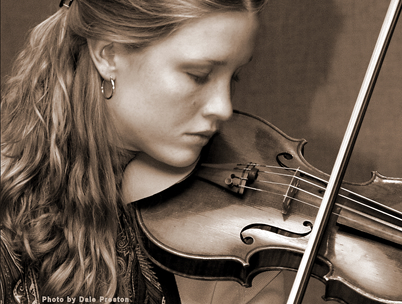By Stephen Brookes • The Washington Post • December 20, 2011
Andrew Arceci and John McKean — a youngish duo playing viola da gamba and harpsichord, respectively — have been building a name for themselves lately as thoughtful interpreters of historically informed early music. They arrived in town with augmented forces on Sunday afternoon, putting on an imaginative program at the Phillips Collection that veered off the beaten Baroque track to explore rarely-heard gems from the likes of Johann Jakob Froberger and La Sieur de Machy. Adriane PostNot exactly a gem — but intriguing anyway — was Handel’s “Sonata Op. 2 No. 2,” written when the composer was only 14. Angsty it’s not. Handel seems to have been as stately an adolescent as he was an adult, but the willowy Adriane Post, awash in Botticelli curls, did wonders with the lead violin role, drawing a beguiling sound out of her instrument and trading lines deftly with the less willowy but similarly gifted violinist Benjamin Shute. John Armato on the theorbo and Daniel Swenberg on Baroque guitar rounded out the ensemble, weaving spare, delicately plucked accompaniments on this work and others by Johann Rosenmuller, Dietrich Buxtehude, Marin Marais and Arcangelo Corelli.
Adriane PostNot exactly a gem — but intriguing anyway — was Handel’s “Sonata Op. 2 No. 2,” written when the composer was only 14. Angsty it’s not. Handel seems to have been as stately an adolescent as he was an adult, but the willowy Adriane Post, awash in Botticelli curls, did wonders with the lead violin role, drawing a beguiling sound out of her instrument and trading lines deftly with the less willowy but similarly gifted violinist Benjamin Shute. John Armato on the theorbo and Daniel Swenberg on Baroque guitar rounded out the ensemble, weaving spare, delicately plucked accompaniments on this work and others by Johann Rosenmuller, Dietrich Buxtehude, Marin Marais and Arcangelo Corelli.
The playing was detailed and beautifully balanced throughout the afternoon, though a sense of caution often seemed to prevail; the players never really summoned the kind of propulsive, edge-of-the-seat electricity that can make Baroque music so exciting. Arceci and McKean each took a solo turn, though de Machy’s “Suite in G” for solo gamba came off as constricted and often awkwardly phrased, while McKean turned in a reading of Froberger’s “Suite XXX” for harpsichord that was intelligent, precise and well-behaved to a fault.